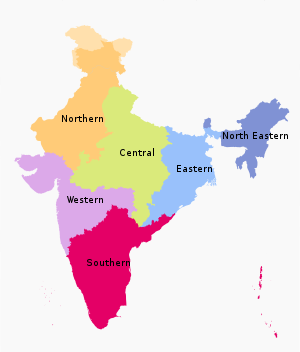
India is a federal union comprising 28 states and 9 union territories, with a total of 37 entities. The states and union territories are further subdivided into districts and smaller administrative divisions.

Bombay State was a large Indian state created at the time of India's Independence, with other regions being added to it in the succeeding years. Bombay Presidency was merged with the princely states of Baroda, Western India and Gujarat and the Deccan States.

Travancore–Cochin, or Thiru–Kochi, was a short-lived state of India (1949–1956). It was originally called United State of Travancore and Cochin following the merger of two former kingdoms, Travancore and Cochin on 1 July 1949. Its original capital was Thiruvananthapuram. It was renamed State of Travancore–Cochin in January 1950. Travancore merged with erstwhile princely state of Cochin to form Travancore–Cochin in 1950. The five Tamil-majority Taluks of Vilavancode, Kalkulam, Thovalai, Agastheeswaram, and Sengottai were transferred from Travancore-Cochin to Madras State in 1956. The Malayalam-speaking regions of the Travancore–Cochin merged with the Malabar District and the Kasaragod Taluk of South Canara district in Madras State to form the modern Malayalam-state of Kerala on 1 November 1956, according to the States Reorganisation Act, 1956 passed by the Government of India.
This article is about the first election held in Independent India in 1951-52.
The administrative divisions of India are subnational administrative units of India; they are composed of a nested hierarchy of administrative divisions.

This is a list of proposed states and union territories in India. The constitutional power to create new states and union territories in India is solely reserved with the Parliament of India. The parliament can do so by announcing new states/union territories, separating territory from an existing state or merging two or more states/union territories or parts of them. In addition to the existing 28 states and 8 union territories, several new states and union territories have been proposed throughout India's history.
The States Reorganisation Commission (SRC) constituted by the Central Government of India in August 1953 to recommend the reorganization of state boundaries. In October 1955, after two years of study, the Commission, comprising Justice Fazal Ali, K. M. Panikkar and H. N. Kunzru, submitted its report. The commission's recommendations were accepted with some modifications and implemented in the States Reorganisation Act in November, 1956. The act provided that India's state boundaries should be reorganised to form 14 states and 6 centrally administered territories.

The States Reorganisation Act, 1956 was a major reform of the boundaries of India's states and territories, organising them along linguistic lines.
The Kerala Legislative Assembly election of 1957 was the first assembly election in the Indian state of Kerala. The Communist Party of India won the election with 60 seats. The election led to the formation of first democratically elected communist government in India.

Northern Zonal Council is a zonal council that comprises the states and union territories of Chandigarh, National Capital Territory of Delhi, Haryana, Himachal Pradesh, Jammu and Kashmir, Punjab, Rajasthan and Ladakh.

Central Zonal Council is a zonal council that comprises the states of Chhattisgarh, Madhya Pradesh, Uttar Pradesh, and Uttarakhand.

Eastern Zonal Council is a zonal council that comprises the states of Bihar, Jharkhand, Odisha, and West Bengal.

Western Zonal Council is a zonal council comprising the states of Goa, Gujarat, Maharashtra and the Union Territory of Dadra and Nagar Haveli and Daman and Diu.>

Zonal Councils are advisory councils and are made up of the states of India that have been grouped into five zones to foster cooperation among them. These were set up vide Part-III of the States Reorganisation Act, 1956.

The North-Eastern Areas (Reorganisation) Act, 1971 was a major reform of the boundaries of India's North-East region into States and union territories.








